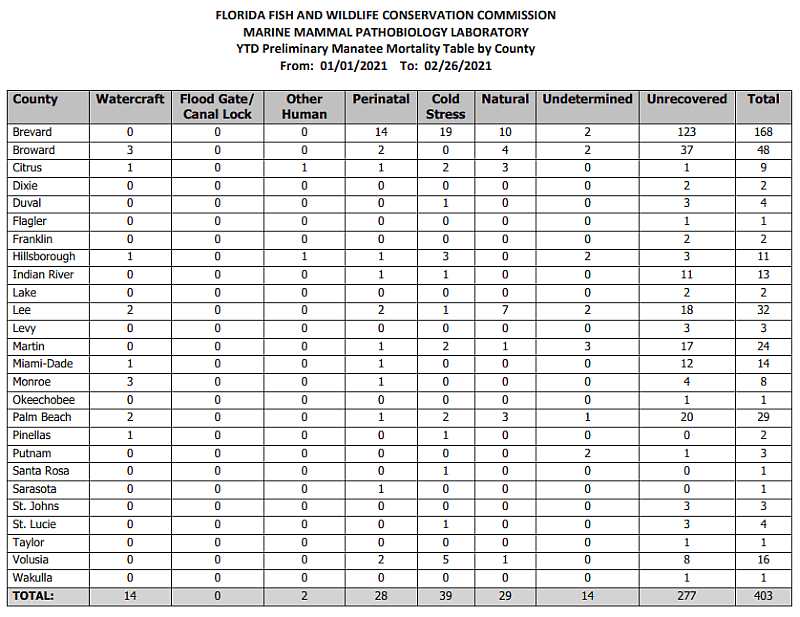IRLNews:2021-03-07/Indian River Lagoon Manatee Mortality
254 (63%) of Florida's total reported manatee deaths were within the Indian River Lagoon National Estuary watershed.[2]
Brevard County reported an incredible 168 manatee deaths in the first 57 days of 2021.
- Volusia = 16
- Brevard = 168
- Indian River = 13
- St. Lucie = 4
- Martin = 24
- Palm Beach = 29
Why does Brevard County have more manatee deaths than any other county in Florida?
There are many factors affecting Brevard's manatee population. All due to human impact.
Natural Migration Interruption
There are an abnormal amount of manatees in the Port St. John's area of the North Indian River Lagoon due to the warm water discharge from the electric power plant. Manatees would normally migrate south as the temperature drops, but the power plant's warm water outflow distracts them from their natural migration. Port St. John's resident manatee population is estimated at 500 individuals, during cold weather the population may increase to well over a 1,000.
Pollution
Nutrient pollution from vehicle emissions, aging septic/sewer systems, and fertilizer laden stormwater, has increased the levels of Nitrogen and Phosphorus in the estuary. These excessive nutrients feed the spring algae blooms, which cloud the water and block the sun, which causes the seagrass to die.
North IRL recipe for disaster: Take a 7 million gallon sewage spill, add the excrement of 500 one thousand pound manatees, stir into a non-flowing water compartment, and bake in the hot Florida sun until pea soup green.
Loss of Seagrass
It is estimated that the Indian River Lagoon has lost 54% of the record high seagrass coverage recorded in 2007.[3] The bottom of the North IRL looks like a barren desert.
Manatees may eat up to 10% of their body weight daily and there just isn't enough seagrass growing in the North IRL to feed the unnaturally large population.
Loss of Habitat
Most of Brevard's shoreline's are lined with seawalls or impoundment dikes, there isn't much living shoreline remaining.
Manatees have been known to eat shoreline vegetation in Brevard's residential canals, but they can't climb the lagoon's hard embankments to reach it.
Compartmentalization
There are eight earthen berm causeways across the North Indian River and five across the Banana River.
These earthen berm causeways act as dams to block 80% or more of the lagoon's width. Only a small percentage of the lagoon is spanned by Intracoastal Waterway bridges.
Building a causeway every few miles has compartmentalized the Banana and Indian Rivers. Each compartment has it's own feeders, tributaries, drainage canals and saltwater inflows.
Some North IRL compartments have no inflows at all; have a very low water exchange rate; and nutrient pollution might remain for over 200 days.[4]
From the Water
Brevard boaters and anglers have been reporting the unusual manatee deaths since December, 2020.
"We should have worked to restore the migration when the lagoon was still healthy, instead of allowing a historic population of 200-300 migratory manatees, that occupied the upper IRL for only part of the year, to grow into a population of over 2000 animals, 1/3 of the states entire population, that now live in and help cause damage to the upper IRL year round.
NASA has been studying overgrazing of the upper lagoons sea grass by this unnatural manatee herd for decades. Manatee organizations and FWC have started to realize the mistake in allowing over reliance on thermal pollution from power plants, but now it’s too late because the manatees are trapped and starving.
This tragic die off that has happened to every other species in the lagoon and now to the manatees is not preventable at this point and we need to focus our efforts on doing what’s right for the manatees and the lagoon, restoring their natural migration before the FPL Frontenac plant is taken offline completely and thousands of manatees die of cold stress much less starvation."commented Billy Rotne, North IRL and Mosquito Lagoon Guide.
Web Links
- DB News-Journal: Manatees Dying. Seagrass Gone
- Bloomberg Businessweek: Nobody Knows How to Wean Manatees Off of Power Plants
Documents
- FWC 2021 Preliminary Manatee Mortality Table (PDF 14pp 562KB)
- FWC 2021 YTD Manatee Mortality Table (PDF 1p 113KB)
- IRL Flushing Model Experiments (PDF 36pp)
References
- ↑ FWC 2021 Preliminary Manatee Mortality Table (PDF 14pp 562KB), retrieved on 2021-03-07.
- ↑ FWC 2021 YTD Manatee Mortality Table (PDF 1p 113KB), retrieved 2021-03-07
- ↑ Dr. Chuck Jacoby, SJRWMD, 2020 Water Quality Presentation Video, retrieved: October 11, 2020
- ↑ IRL Flushing Model Experiments (PDF 36pp), September 2018, Dr. Gary Zarillo, Florida Tech. retrieved on 2021-03-07.



